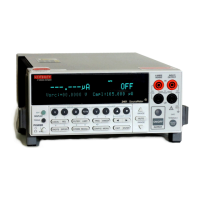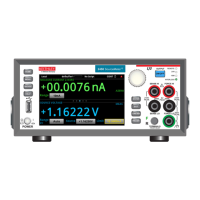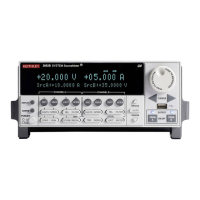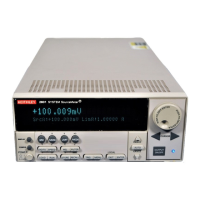12 Quick Results Guide
Measure only (V or I)
The SourceMeter can be used to measure voltage only (voltmeter) or current only (amme-
ter). The procedure to measure only is provided in Table 3.
CAUTION 1
When using the SourceMeter as a voltmeter only, voltage compliance must
be set higher than the voltage that is being measured. Failure to do so
could result in instrument damage due to excessive current that will flow
into the SourceMeter.
CAUTION 2 When using the SourceMeter as a voltmeter only, DO NOT use auto range
and NEVER select a measurement range that is below the applied signal
level. Otherwise, high current drawn from the external source could dam-
age the external source or the test circuit.
Table 3
Measure only (V or I) procedure
Procedure Details
1. Select source-measure
functions.
To measure voltage, press SOURCE I and MEAS V. To mea-
sure current, press SOURCE V and MEAS I.
2. Set source level to zero. Use DISPLAY EDIT key to place cursor in source field (Vsrc
or Isrc), use RANGE
key to select lowest range, press
MENU to display zero source level, then press ENTER.
3. Set compliance higher than
the expected measurement
(see CAUTION 1).
Use DISPLAY EDIT key to place cursor in Cmpl field, use
RANGE
and keys to select range, use edit keys to key
in compliance value, then press ENTER.
4. Select measurement range
(see Note).
Use RANGE and keys to select a fixed measurement
range. For best accuracy, use the lowest possible range.
5. Connect voltage or current
to be measured.
Connect DUT to SourceMeter using 2-wire connections (see
Figure 3).
6. Turn output on and take
reading from display.
Press ON/OFF OUTPUT key. Red OUTPUT indicator on.
7. Turn output off when
finished.
Press ON/OFF OUTPUT key. Red OUTPUT indicator off.
Note: When measuring current, auto range can be used. When measuring voltage, DO NOT use auto range
(see CAUTION 2).
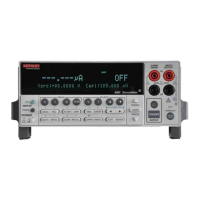
